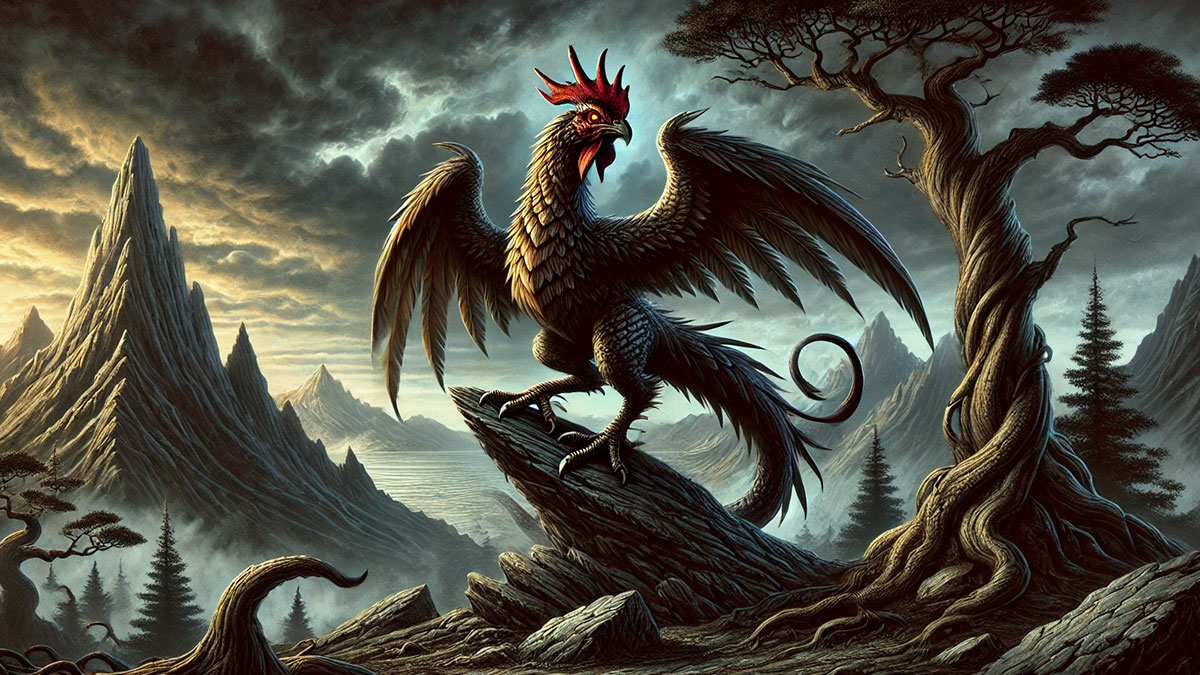A cockatrice is a mythical creature commonly found in England that has the head of a rooster but the tail of a serpent. It resembles a two-legged dragon, a wyvern, or a basilisk. The creature is highly poisonous and can kill with its breath or even just a stare.
The cockatrice shares many characteristics with a wyvern, it too has wings, just two legs, and a serpent’s tail, but it has the head of a rooster (a “cock” in British English). The former also has the legs and feet of a rooster, whereas a wyvern usually has the feet of a dragon or an eagle.
The origin of the cockatrice is quite strange. It reportedly comes from a union between a rooster and a toad or serpent. However, the rooster lays the egg.
Cockatrice is born from the egg of a rooster
Legend states that at one time, a rooster/cock had the ability to lay eggs, which were then minded and hatched by a toad or a serpent; this hatchling would then grow into a cockatrice. According to Frederick Edward Hulme, a 19th-century professor at Kings College London, a medieval document found in the library at Brussels explained the process as follows:
“When the cock is past seven years old an egg grows within him, whereat he greatly wonders. He seeks privately a warm place, and scratches a hole for a nest, to which he goes ten times daily. A toad privily watches him, and examines the nest every day to see if the egg be yet laid. When the toad finds the egg he rejoices much, and at length hatches it, bringing forth an animal with the head, neck, and breast of a cock, and from thence downward the body of a serpent.”
Hulme recounted an incident in the Swiss city of Basle in 1474 when a rooster was accused of laying a cockatrice egg. The city authorities put the offending rooster on trial, and it was soon sentenced to death. The sentence was carried out in the marketplace, where its remains were burnt with the egg. According to the account, the townspeople were overjoyed that the city rulers had promptly averted disaster.
Cockatrice came from medieval literature and the first English Bible
The cockatrice first appeared in medieval English literature and was featured in John Wycliffe’s Bible. Written in the 14th century, Wycliffe’s version of the Bible is considered the first English translation of the sacred text. Subsequently, the cockatrice appeared in the better-known King James Version of the Bible, published in the early 17th century. However, Biblical scholars generally accept that the cockatrice is a mistranslation of the original Hebrew words for snakes or serpents.
The cockatrice first appears in Psalm 91:13 of the Wycliffe Bible: “Thou shalt go upon a snake, and a cockatrice; and thou shalt defoul a lion, and a dragon (and thou shalt trample upon a lion, and a dragon).”
It also appears in Proverbs 23:32: “But at the last it shall bite as an adder, and as a cockatrice it shall shed abroad venoms. (but in the end, it shall bite like a serpent, and it shall sting, with its venom, like a cockatrice.)” And again in Isaiah 11:8: “A young sucking child from the teat shall delight on the hole of a snake, and he that is weaned shall put his hand in the cave of the cockatrice.” The creature is mentioned three more times in Isaiah.
The cockatrice: From Shakespeare to Harry Potter
Shakespeare mentions a cockatrice in his play Romeo & Juliet. In Act 3, Scene 2, Juliet fears that Romeo has killed himself, and she speaks of the “poison” of “the death darting eye of cockatrice.” This is clearly a reference to the deadly stare of the creature. Shakespeare refers to this deadly stare in two more plays. In Richard III: “A cockatrice hast thou hatched into the world whose unavoided eye is murtherous,” and the Twelfth Night: “This will so fright them both, that they will kill one another by the look like cockatrices.”
The cockatrice appears in modern literature, such as the 2000 JK Rowling novel Harry Potter and the Goblet of Fire. In chapter 15, Hermione Granger states that at the 1792 Triwizard Tournament, one task involved capturing a cockatrice; however, the beast escaped and went on the rampage, injuring numerous people. As a result of the incident, the tournament was postponed for 200 years.
The word “cockatrice” reportedly comes from the medieval French word cocatris, which is thought to be a translation of the Greek word ichneumon, which means “tracker.” Ichneumon also relates to a weasel-like Egyptian animal; in legends about basilisks, which are thought to be similar to cockatrices, weasel-like animals were the only creatures that could kill a basilisk.
A reader may come across many different spellings of cockatrice, including but not exclusive to cocatrice, cokatrice, kokatrice, kocatrice, cockatryse, cocatryse, cocautrice, cockautrice, coccatryse, cocatris, kokatrix, and chocatrix.
As with wyverns, griffins, dragons, and basilisks, the cockatrice is often used in heraldry but is not as common as the aforementioned creatures.
References
BibleGateway.com, “John Wycliffe Version,” accessed August 22, 2024.
Britannica.com, “Cockatrice,” accessed August 22, 2024.
Gough, Henry and Parker, James. “A Glossary of Terms Used in Heraldry.” Pub.: J. Parker, (1894), accessed August 22, 2024.
Hulme, Frederick Edward. “Natural History, Lore and Legend.” Pub.: B. Quaritch, (1895), accessed August 22, 2024.
Myshakespeare.com, “Romeo & Juliet,” accessed August 22, 2024.
Rowling, JK. Harry Potter and the Goblet of Fire. Pub: Bloomsbury, (2000).
Timbs, John. “Curiosities of Animal and Vegetable Life.” Pub.: C. Griffin, (1872), accessed August 22, 2024.
Whitaker’s Words Online. “Ichneumon,” accessed August 22, 2024.
